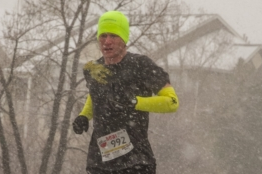We’re entering that time of year when training becomes more difficult. Though the holidays are winding down and schedules may ease a bit, even for the most dedicated of runners there are unyielding foes for the next several months: the effects of winter weather. With gym capacities currently reduced, running on an indoor track or treadmill may be more difficult, and possibly not advisable. Yet, getting outside in poor conditions isn’t impossible and even if you own a treadmill, there may be more opportunities to run outside than would seem apparent at first.
Oddly, the first day of a snowstorm can provide the best snow to run in. Though it is slippery and it requires caution to run, the accumulating powder is far better than what you can get into on the days following the storms. If we have a snow heading our way, I’m definitely planning to get out on that first day.
Once the snow has been on the ground for a while, it gets packed down and much more slippery. The foot traffic has not compacted it evenly and some patches will melt more quickly than others, making for a bumpy and potentially uncomfortable run. There are methods to avoid this. If the weather has warmed a bit and some snow has melted, consider areas near your home that are well exposed to the sun and are likely to have cleared more. These may provide good routes while you wait for the shadier areas to melt and dry off. (Hint: for those of us in the northern hemisphere, the south-facing sidewalks that are unobstructed by trees and sidewalks are the ones where this occurs the fastest.)
If the snowpack is thick and/or there’s ice and it’s not going away, a good pair of YakTrax or other traction devices can keep you upright. They’re not the most comfortable items to wear and they’re not built for speed, but compared against a broken limb, these side effects are well worth it. If you’re dealing with solid ice, it may be best to consider a day off. It’s an unforgiving surface.
Flexibility in your training schedule is also a way around the snow and ice. For example, if you’re planning a long run on a Sunday but the forecast is for snow, then consider trading out your Sunday and Saturday runs. It may also be that the overall schedule has to get adjusted. If it’s an excessively snowy, icy winter then extensive speedwork and training miles may not pan out exactly the way you want. You can still get out there, but making slight adjustments may be necessary.
Though there may be times to avoid running outside, such as when there’s solid ice, if there is a little snow or if the surfaces are starting to ease a bit in terms of being slippery, I find it beneficial to run on them. It can take a little more focus and speed adjustment, but it acclimates your body and mind to a different set of running circumstances. From a pragmatic standpoint, if you’re planning to do a few races this prepares you for a condition that can show up on race day, even in the late fall or early spring. From a comparison standpoint, it can allow you to appreciate the sunny, seventy degree days that will follow in the spring and summer. And, there can be a lot of enjoyment. One of my favorite winter runs of the past several years came during a snowstorm when a couple of friends and I hit the local trails. Set just a short distance away from the city, it was far enough to provide a quiet, serene escape for an evening.
Running and training in winter provides challenges. It’s the reason I wouldn’t pick an early spring race to peak for a certain goal time because who knows whether the training schedule will hold. Yet, with a little planning ahead and flexibility, it’s still possible to stay out there and moving.

Running anecdotes, running food reviews, some race coverage, and more